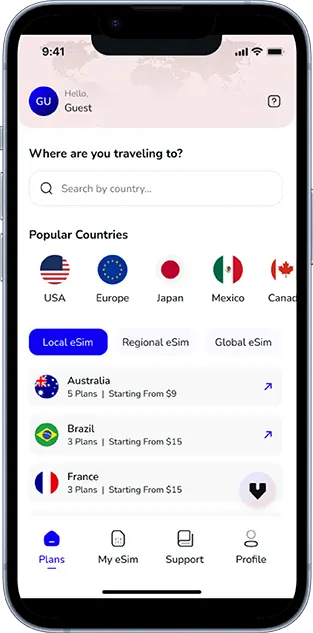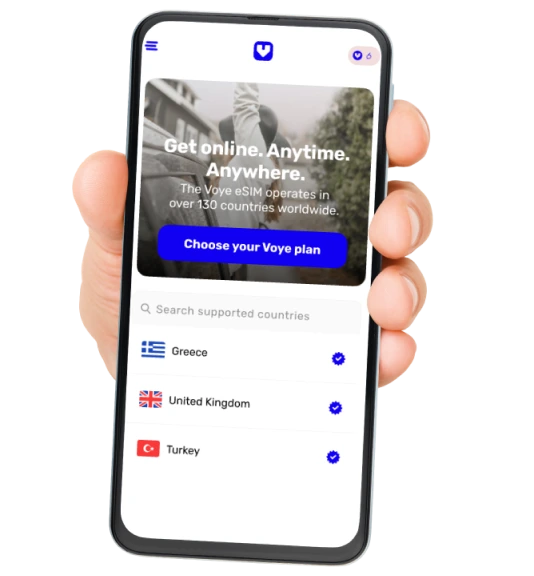Note that iPhone devices from Mainland China aren’t eSIM compatible. Also iPhone devices from Hong Kong and Macao aren’t compatible (except for iPhone 13 Mini, iPhone 12 Mini, iPhone SE 2020 and iPhone XS)
In today’s rapidly evolving digital landscape, airlines and airports continuously explore innovative ways to enhance the passenger experience. One of the most promising advancements is adopting eSIM (embedded SIM) technology. By enabling seamless connectivity, eSIM is revolutionizing how passengers stay connected during their travels. This article delves into how airlines and airports are leveraging eSIM technology to ensure passenger convenience, improve operational efficiency, and enhance overall travel experiences.
What is eSIM?
An eSIM (embedded SIM) is a digital SIM card that eliminates the need for a physical SIM card. Embedded directly into a device, it allows users to switch between mobile carriers and data plans without swapping SIM cards physically. eSIM technology provides:
- Global Connectivity: Easily switch between networks in different countries.
- Convenience: Activate plans remotely without visiting a store.
- Space Efficiency: Frees up space in devices for other components.
This technology has become especially significant for travelers seeking uninterrupted connectivity while navigating through airports and during flights.
The Role of eSIM in Enhancing Passenger Convenience
1. Seamless Roaming Services
Airlines and airports are partnering with eSIM providers to offer passengers access to high-speed internet as soon as they land. With eSIM, travelers can:
- Instantly connect to a local network without purchasing a physical SIM.
- Avoid expensive international roaming charges.
- Enjoy uninterrupted communication throughout their journey.
2. Digital Boarding Passes and Real-Time Updates
eSIM-enabled devices facilitate better utilization of airline apps, allowing passengers to:
- Access digital boarding passes without relying on Wi-Fi.
- Receive real-time flight updates, gate changes, and delay notifications.
- Communicate directly with customer support.
3. In-Flight Connectivity
Several airlines are integrating eSIM technology to improve in-flight connectivity. Passengers can:
- Stay connected to Wi-Fi networks powered by eSIM partnerships.
- Access entertainment and productivity tools without disruptions.
- Use messaging services even on remote flight routes.
4. Streamlining Airport Operations
Airports are adopting eSIM technology to:
- Enable real-time communication between staff members.
- Enhance passenger tracking and security measures.
- Simplify navigation through indoor positioning systems.
Your Journey, Our eSIM
Stay online abroad with instant activation.
How Airlines Are Integrating eSIM
Partnerships with eSIM Providers
Airlines are collaborating with global eSIM providers to integrate connectivity solutions into their travel services. Examples include:
- Pre-Flight Activation: Passengers can purchase eSIM plans directly through airline apps.
- Custom Packages: Airlines offer region-specific eSIM data plans bundled with ticket bookings.
Enhancing Loyalty Programs
eSIM technology is being incorporated into airline loyalty programs. Frequent flyers benefit from:
- Complimentary eSIM plans for specific destinations.
- Discounts on data packages as part of reward programs.
Streamlined Check-Ins
By leveraging eSIM, airlines are enabling digital check-ins even in areas with poor Wi-Fi connectivity. This ensures:
- Faster processing times.
- Reduced queues at counters.
- A more stress-free boarding experience.
How Airports Are Leveraging eSIM
Improving Passenger Connectivity
Airports worldwide are embedding eSIM technology into their operations to ensure passengers remain connected. This includes:
- Providing access to local eSIM plans via kiosks.
- Partnering with mobile carriers to offer exclusive airport eSIM packages.
Enhancing Navigation and Services
With eSIM, airports can offer enhanced navigation tools, such as:
- Interactive maps for easier terminal navigation.
- Real-time alerts for gate changes and boarding announcements.
Smart Airport Solutions
Airports are integrating eSIM to power smart technologies like:
- IoT-enabled baggage tracking systems.
- Automated check-in counters and boarding gates.
Case Studies: eSIM Adoption in Airlines and Airports
Singapore Airlines
Singapore Airlines has collaborated with eSIM providers to offer seamless connectivity to passengers traveling to various destinations. Their in-app eSIM feature ensures:
- Instant activation of data plans for different countries.
- Real-time updates and notifications for smoother travel.
Dubai International Airport
Dubai International Airport provides passengers with access to eSIM kiosks where they can:
- Purchase local eSIM plans instantly.
- Enjoy high-speed internet without visiting a carrier store.
Lufthansa
Lufthansa’s integration of eSIM technology allows passengers to:
- Connect to in-flight Wi-Fi using eSIM-enabled devices.
- Access personalized entertainment options without interruptions.
Global Coverage, Local Rates
Experience hassle-free connectivity wherever you go.
Future Prospects of eSIM in Travel
Wider Integration in Airport Infrastructure
Airports are expected to integrate eSIM into their infrastructure further, enabling:
- Contactless entry and exit systems.
- Enhanced passenger tracking for improved safety.
Expanding Airline Offerings
Airlines are exploring ways to bundle eSIM services with travel packages, making connectivity an integral part of the travel experience.
eSIM for Sustainable Travel
By reducing the need for physical SIM cards, eSIM contributes to:
- Decreased plastic waste.
- Environmentally friendly travel solutions.
Benefits of eSIM Adoption for Stakeholders
For Passengers
- Cost Savings: Avoid international roaming fees.
- Convenience: No need to purchase physical SIM cards.
- Seamless Experience: Stay connected from departure to arrival.
For Airlines
- Enhanced Loyalty: Improved passenger satisfaction.
- Operational Efficiency: Streamlined check-in and boarding processes.
- Revenue Opportunities: Sale of eSIM packages.
For Airports
- Improved Services: Better passenger experience.
- Modernized Infrastructure: Advanced navigation and IoT solutions.
- Increased Revenue: Partnerships with eSIM providers.
Conclusion
The adoption of eSIM technology by airlines and airports marks a significant leap forward in enhancing passenger convenience. By ensuring seamless connectivity, real-time updates, and a more personalized travel experience, eSIM is set to redefine how we travel. As more airlines and airports embrace this technology, the future of air travel looks more connected and passenger-friendly than ever before.
Seamless Mobile Data Everywhere
















